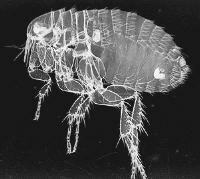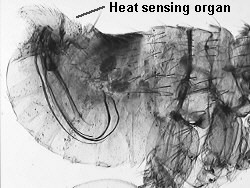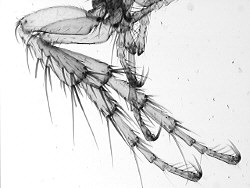

This month - flea circus!
Fleas seem
to get a 'bad press', which is hardly surprising as they are
unwanted 'guests' on our pets or in our houses. They are or have
been the vectors of a number of serious diseases including
Bubonic Plague, i.e. the Black Death of the Middle Ages which
killed one quarter of the population of Europe.
However, they are amazing insects and as we like to celebrate the wonders of the miniature world 'warts and all' here on Micscape, this month we take a closer look at these fascinating critters.
Flea factfile - some itchy facts about fleas (source and quotes from Enycylopaedia Britannica 15th edition, 1993 printing, entry for 'flea' in Micropaedia)
fleas are 'wingless, blood-sucking insects of the Order Siphonaptera'
there are over 1600 species known and can be found in many habitats including some of the world's coldest and hottest regions
the length of an adult flea can be between 1 to 10mm (whoa, I'll stay well clear of a flea 1cm long, does anyone know where the largest species lives?). Article update: Mike Dingley of Australia tells me 'it is Hystrichopsilla schefferi, and was found in the nest of a mountain beaver in 1913 and measured 8mm.' Thanks Mike!
'powerful leg muscles enable fleas to jump distances up to 200 times their body length', (equivalent to a 2m man jumping 400m, whereas the typical Olympic long jumper achieves 8.7m)
their great strength for their size 'allows fleas to pull miniature carts and perform other stunts in 'flea circuses'' - popular in Victorian times but still performed by some entertainers (a web search with 'flea circus' will find a number of intriguing web sites describing how they are trained and the stunts they can do)
Fleas - built for purpose
their flattened shape enables them to move easily on the often hairy skin of a host
the backward pointed bristles don't hinder their forward movement but make them especially difficult to be dislodged or removed
they are able to detect the body heat of a new host by a heat sensing organ on their posterior called the sensillum
their prowess in jumping with their large powerful hind legs enables them to attach themselves to a host from some distance away
Oriental rat flea
 The image left shows a
prepared slide of the Oriental rat flea (Xenopsylla cheopsis).
(The image is a 'bas relief' derived from an optical
photomicrograph to highlight the flea's shape and form). This
flea is one of the main species responsible for transmitting
bubonic plague. (There are many sites on the web describing
this disease and the role played by the flea in it's
transmission, try 'bubonic plague' on a web search engine.)
The image left shows a
prepared slide of the Oriental rat flea (Xenopsylla cheopsis).
(The image is a 'bas relief' derived from an optical
photomicrograph to highlight the flea's shape and form). This
flea is one of the main species responsible for transmitting
bubonic plague. (There are many sites on the web describing
this disease and the role played by the flea in it's
transmission, try 'bubonic plague' on a web search engine.)
Cat flea

The image right shows a cat flea. Notice the dark brown stiff comb-like hairs which the rat flea above doesn't possess.
 The head of the cat flea larva is shown on
the left. The female lays eggs on the host or it's habitat which
hatch to legless larvae. After a few molts a cocoon is spun and
enters the pupal stage. Eventually the adult flea emerges. Adult
fleas live from a few weeks to over a year.
The head of the cat flea larva is shown on
the left. The female lays eggs on the host or it's habitat which
hatch to legless larvae. After a few molts a cocoon is spun and
enters the pupal stage. Eventually the adult flea emerges. Adult
fleas live from a few weeks to over a year.
Hedgehog flea
 |
Hedgehog flea body |
| Hedgehog flea head. The sucking mouthparts are barbed making fleas difficult to remove. |
 |
 |
Hedgehog flea legs. Notice the claws which enable them to grip the host |
Water fleas?
 Some of the little creatures
you can commonly find in a pond are colloquially known as water
fleas e.g. the Daphnia and similar species of the so-called
'Cladocera' shown left. The term is sometimes applied to Copepods
as well (e.g. Cyclops species). They are called 'water-fleas'
because they do move somewhat reminiscent of a flea but they are
not insects or related to true fleas in any way. 'Water fleas'
are fascinating creatures and we hope to look at them in a
Micscape article in more detail in the near future. The
delightful animation shown left is © Wim van Egmond. (Visit Wim's
home page
where an animated protozoa can be seen).
Some of the little creatures
you can commonly find in a pond are colloquially known as water
fleas e.g. the Daphnia and similar species of the so-called
'Cladocera' shown left. The term is sometimes applied to Copepods
as well (e.g. Cyclops species). They are called 'water-fleas'
because they do move somewhat reminiscent of a flea but they are
not insects or related to true fleas in any way. 'Water fleas'
are fascinating creatures and we hope to look at them in a
Micscape article in more detail in the near future. The
delightful animation shown left is © Wim van Egmond. (Visit Wim's
home page
where an animated protozoa can be seen).
Taking a closer look at fleas yourself
It's probably best to seek good local advice (e.g. a local council Environmental Health Department) in your own country before searching for fleas yourself if there's a possibility they are known vectors of disease. If in any doubt buying prepared slides is a safer option! In the UK, cats, dogs and hedgehogs are potential sources of fleas but beware of and take precautions against spreading an infestation if collecting and examining live.
An excellent series of booklets on killing and preparing whole and dissected mounts of insects is available from Northern Biological Supplies (follow shop links).
If preparing slides doesn't appeal or is not feasible, many of the supply houses may have one or more flea species available as a prepared slide. Biosil in the UK for example can offer prepared slides of a cat flea (adult and larva) and hedgehog flea. In the US check out the catalogues of companies like Edmund Scientific, Carolina Biological Supplies and Wards.
Acknowledgements.
'The Fabulous Flea Circus' Shockwave animation shown above is
freeware available from http://www.adveract.com/shokbobl/baubles/flea.htm.
Images of an oriental rat flea taken froma prepared slide by John Atkinson (the author's brother in law), other flea slides prepared by John Wells, UK. Water flea animation by Wim van Egmond.
Further reading The above is just a flavour of the many fascinating aspects of fleas. Most large encyclopaedias should have a good section under 'Insects' on fleas. eg Encyclopaedia Britannica.
Footnote:
![]() You need a Macromedia Shockwave
plug-in for your browser for this to work. Click button to
download appropriate 'Director' plug-in. Return to article.
You need a Macromedia Shockwave
plug-in for your browser for this to work. Click button to
download appropriate 'Director' plug-in. Return to article.
First published in June 1998 Micscape Magazine.
Please report any Web problems
or offer general comments to the Micscape Editor,
via the contact on current Micscape Index.
Micscape is the on-line monthly
magazine of the Microscopy UK web
site at Microscopy-UK